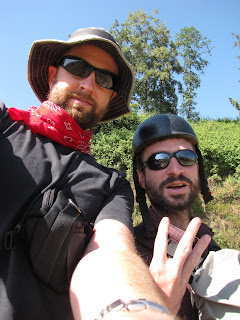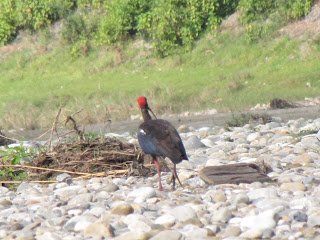Can you imagine a whole month:
--without checking your e-mail
--without answering the phone
--without watching TV
--without reading the news
--preparing all your meals without a gas/electric range, microwave or fridge?
--sleeping in a room that is 40 degrees
--taking a shower with water from an icy mountain stream?
Well, these are some of the features of going on a Buddhist meditation retreat in the mountains of Nepal, which I did the whole month of November. And it was wonderful!
One of the main objectives of a Buddhist mountain retreat is to transcend attachment & aversion-- the likes and dislikes that lead to perpetual mental suffering. When I lived in New York City, this became evident for me at my job, as many of my friends left and I was mostly surrounded by people I didn't get along with. I left that job and NYC with it and this mountain retreat was a way for me to move beyond those memories and transform my basic outlook to handle adversity with more skill the next time it arises. One of the main practices of the retreat was equanimity meditation--extending the same kindness and care to all without the labels of "friend" and "enemy" and thereby dissipating the conflicting emotions that arise from such labels.
I did four sessions of practice a day--before and after all meals. I followed a prayer sequence called "Heart Essence of the Vast Expanse Preliminaries" composed in the 18th century by Jigme Lingpa, a Tibetan Buddhist saint. The famous book "Words of My Perfect Teacher" is a commentary on this practice.
I first studied it with a master named Changling Rinpoche at Shechen Monastery in Kathmandu during my study abroad program in 1999/2000. I received the transmission from Lama Wangdu Rinpoche in 2000 and again from Shyalpa Rinpoche in 2007. This past month was the first time in all these years where I had an opportunity to engage in the practice intently for an extended period of time.
The practice begins with an overview of basic Buddhist philosophy in the form of a prayer to one's teacher. Impermanence, karma, the suffering of cyclic existence, and the precious opportunity we have to practice spirituality are all covered. Next, one takes refuge in the teacher, the Buddha, the teachings and the spiritual community by saying a prayer and doing prostrations. These consist of placing folded hands to one's head, throat and heart (showing loyalty with and purifying one's body, speech and mind) and then touching both knees, both hands and one's forehead to the ground, which transforms one's anger, attachment, ignorance, envy and arrogance into their enlightened counterparts. I did 1,000 to 2,500 of these prostrations per day during the retreat.
The next practice consists of meditating on boundless equanimity, love, compassion and sympathetic joy while activating one's altruistic motivation to attain enlightenment to effectively help others. Third is a visualization of the Buddha of purification giving you an internal shower to purify your sins while you recite his mantra. This practice concludes with equanimity meditation. Next is the visualization of offering everything good in the universe, in the form of a mandala, to the teacher, the Buddha, those who protect the teachings, those you have harmed and all beings in general. This helps to earn the merit necessary to sustain the practice while also letting go of attachments.
Next is a series of prayers and visualizations which culminates in a trance-like state where you mentally reside in oneness with the wisdom mind of the Buddha for a brief period. Lastly, you dedicate the merits of the practice to the benefit of all.
I prepared all my meals over a primitive wood-burning stove with no door. My diet consisted of potatoes, rice, carrots, greens and lots and lots of lentils. Needless to say, I had to take some hits of meth from time to time--simethicone anti-gas medicine that is! I also occasionally enjoyed soup from packets, peanut butter and candy. I used loads of ginger, garlic and onions and spices in all my cooking and sometimes a hot pepper called "fireball." One time my meditation neighbor brought me some fresh Tibetan steamed dumplings filled with spinach and garlic with a tomato/hot pepper dipping sauce. This was the culinary highlight of the retreat.
My cabin had 2 small rooms--one for the stove, one for the bed. I had a lovely yard that overlooked the valley, where I spent my breaks. My water came via hose directly from a mountain stream. I received large chunks of firewood from a local and chopped it up with my axe or khukari, a curved Nepali sword/knife that all locals have. Per rules of the retreat, I was not allowed to leave the vicinity of my cabin, though neighbors would sometimes visit me on breaks.
The retreat center is also a sanctuary for goats rescued from slaughter by Chatral Rinpoche, the 98-year-old master whom I compiled a book on. There are 160 goats and every afternoon, they are taken out to graze and fed leaves from cut branches. The meditators at the center had to do some "goat duty" for most of the time I was there, the some professional goat herders were hired at the end to relieve them of this. On one occasion, a goat herder accidentally cut his leg with a khukari and I was called up with my first aid kit to help. He had severed some muscle tissue with lots of bleeding. I offered to do stitches, but he declined so I cleaned it and wrapped it up tight. The next morning, after I re-treated the wound with plenty of Neosporin and gave him some Advil, he limped 4 hours to the nearest town with a road and took a bus to Kathmandu to visit the hospital. Minor surgery was required, but he will be fine.
On the 2nd day of the retreat during my evening study session, I leaned over to tend the fire and my sweatpants caught fire from the candle! I patted it out with my hand, but not before a four-inch hole was created and the back of my leg was scorched! Through the power of prayer and aloe treatment, the burn was healed within a few days.
Along the 8 hour uphill hike to the retreat center, I saw Missing Persons signs for a girl from Colorado that disappeared in the area last spring. Theories are that she was either assaulted and killed or that she simply fell to her death in the steep mountains.
Some hooligans broke open a Buddhist monument (stupa) on the hill directly above the retreat center where I stayed, but found no valuables. In my tradition of Tibetan Buddhism, we would say that this type of criminal behavior at a sacred site is a sign of a "degenerate age."
People in this area are a combination of wild/fearless--with large knives connected to their belts like pirates--and kind/generous. It is my kind of place.
My late mother appeared in my dreams numerous times. I felt her spirit was in this particular songbird that would come by my courtyard and sing sweet songs from time to time.
Some bats lived in the eaves of my roof and one time a large one flew directly into my face at full speed! My most frequent visitors were large mountain ravens who enjoyed munching on any leftovers I might have.
About retreats, Jigme Lingpa said, "never leave them as ordinary as you were before." By that standard, I consider it to be a true success.
Below are some photos from the retreat:
The objects of my devotion and prayers during the retreat (and every day for that matter), HH Chatral Rinpoche and HE Shyalpa Rinpoche

This is where I slept and did my practice.

There is a goat sanctuary with 160 goats below my cabin (saved from the butcher).

Day one of retreat.

One of my neighbors

My cabin.

The moon.

My kitchen.

What I looked like half way through the retreat.

My courtyard, where I ate and relaxed

My water tap with its icy water.

I woke at sunrise each day.

I used this knife to cut my wood and this rosary to count my mantras. (This picture taken at end of retreat).

This man gets all the wood for the residents of the meditation center.

On the last day of my retreat


































































